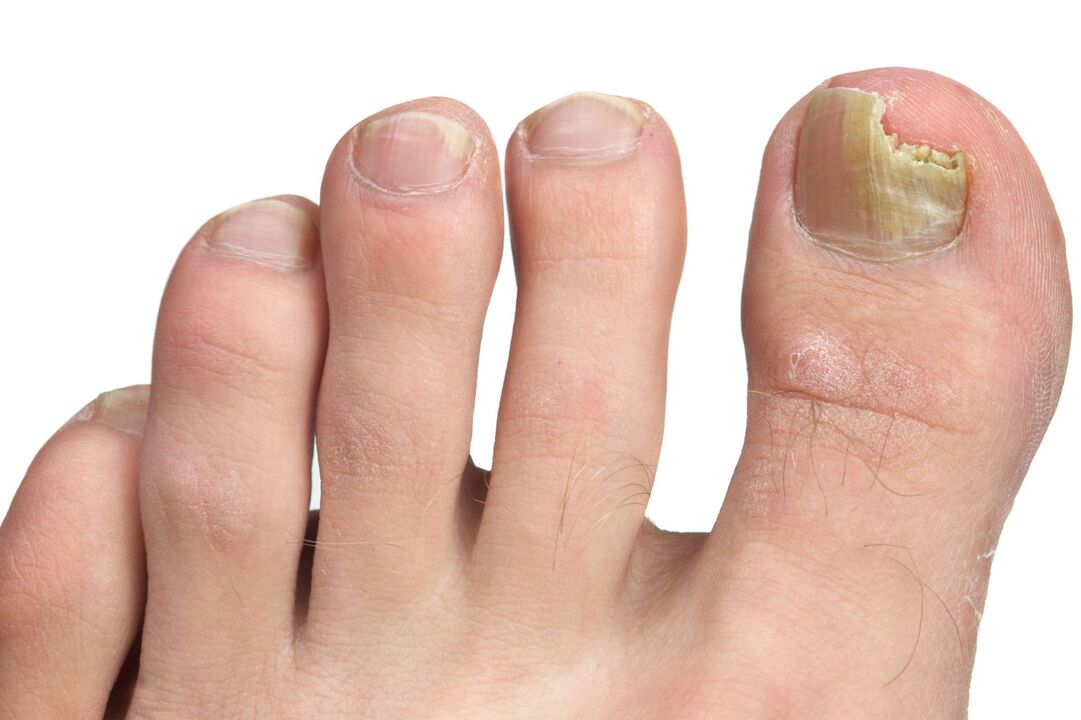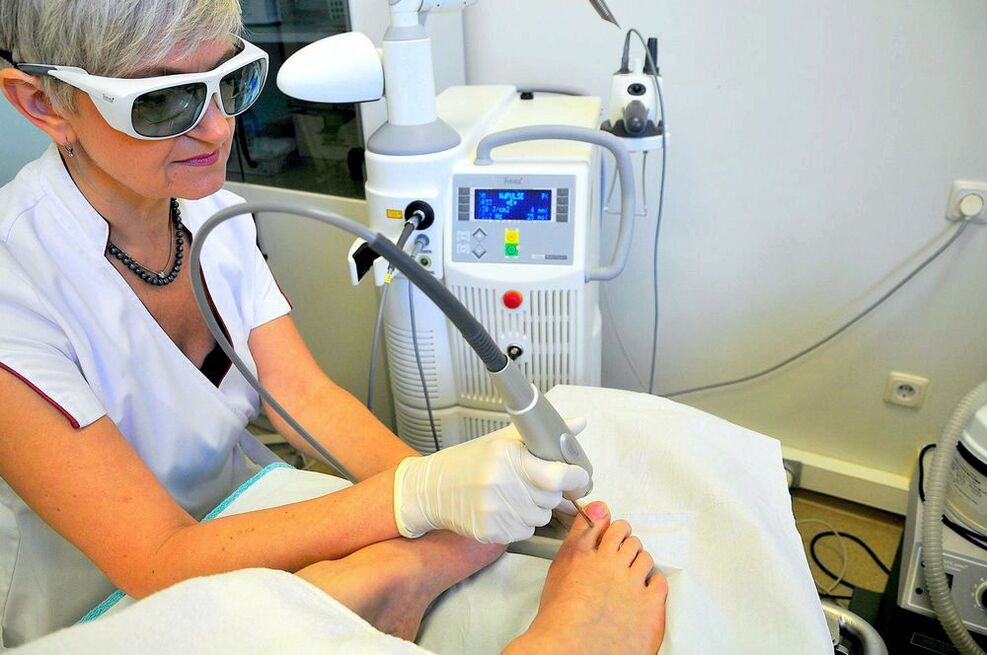
The problem of fungal infection on the toenail plate is common for many. According to medical statistics, this disease worries about 20% of the world's population. Only in the territory of our country more than 15 million people suffer from fungus. Therefore, the problem of how to treat toenail fungus is very relevant today. This disease in the medical environment is also called onychomycosis. The disease is more common among the stronger sex. This is due to the fact that they are more likely to wear closed shoes. And this, in turn, prevents the flow of air to the feet, which contributes to the emergence of a favorable environment for the rapid reproduction of pathogenic microorganisms.
Important!
The information in this section should not be used for self-diagnosis or self-treatment. In case of pain or worsening of other diseases, only the attending physician should prescribe diagnostic tests. For proper diagnosis and treatment, you should contact a specialist.
Disease symptoms
There are about 50 types of fungi that can infect the human body. Therefore, to determine how to treat toenail fungus, you need to know the exact type of infection. The symptoms of the disease also vary depending on which pathogen causes it. When infected with normotrophic fungi in patients:
- there is a change in nail color;
- spots and stripes appear on it;
- onycholysis was observed.
With the atrophic type of the disease, the patient notes that his nails are slowly destroyed. The damage occurs at the outer end and moves towards the nail fold. At first, only a change in the color of the plate indicates the disease. He became:
- gray;
- dull;
- matte.
In the future, there is a complete loss of nails. With hypertrophic fungi, plate thickening is observed. This happens because of the increased growth of skin flakes. As a result, the nail can thicken up to two millimeters and become severely deformed. The following symptoms indicate the appearance of this disease:
- changes in the shape of the nail (the sides are destroyed);
- loss of plate gloss;
- nail yellowing.
Treatment of toenail fungus should be started immediately when signs of lateral and distal lesions appear. These two types of disease often occur in combination. This disease will be manifested by:
- the appearance of transverse grooves on the nails;
- plate color change (from blue-green to black);
- roughness of the affected area.
The disease ends with the complete loss of nails, as well as inflammation of the nail folds. Regardless of the type of lesion, there are symptoms that bother every patient with fungus:
- itching in the affected area;
- plate delamination;
- collapse and lose nails.
Cause
Fungus occurs as a result of tissue damage by mycotic bacteria. In almost 90% of cases, the disease is caused by dermatomycetes. In rarer cases, fungi of the genus Candida, as well as mold microorganisms, become pathogens. Pathogens can penetrate deep into the nail:
- through the dorsal part of the nail;
- from below the distal edge;
- through the proximal fold.

In the first case, the fungus penetrates deep into the nail. This route of infection is characteristic of dermatomycetes. In the second case, the lesion occurs directly under the plate. This greatly complicates the treatment of toenail fungus, because it is difficult to act with drugs directly at the site of infection due to its inaccessibility. Through the proximal roller, infection rarely penetrates. In order for the fungus to enter the nail, certain conditions are required. Increased risk of infection:
- mechanical damage to the nail area;
- wearing narrow and uncomfortable shoes;
- constant contact with water;
- increased sweating;
- exposure to chemicals on the feet;
- non-compliance with personal hygiene rules.
You can get fungus from sick people. The causative agents of this disease are perfectly preserved in moist and warm rooms, so infections most often occur in bathrooms, swimming pools, water parks, and public baths. Fungus can also be transmitted when sharing such items:
- towels
- wiping cloth;
- slippers;
- scissors;
- pumice stone
What doctor treats?
When the first symptoms appear, indicating the progression of the disease, it is recommended to immediately seek medical help. Self-medication is possible, but during the attempt to cope with the disease itself, there is a high probability of infecting all loved ones, as well as provoking the development of complications. Therefore, it is better to trust the professionals. Treatment and diagnosis of nail fungus is carried out by: dermatovenereologist, cosmetologist, podiatrist.
At the first appointment, the patient will be examined. The doctor needs to study the condition of the nail plate, determine the nature and prevalence of the disease. The patient should tell as much as possible about all the complaints, showing his assumptions about the causes of the onset of the disease. To decide how to treat toenail fungus, it is important for the doctor to conduct a survey. The specialist will ask the patient:

- Has there been a similar problem in the past?
- Are there any other health complaints?
- Have you visited a sauna, bath or pool lately?
- Does a relative suffer from nail fungus?
- Are there any chronic diseases?
- How do you try to solve the problem yourself?
It is very important for the doctor to understand the type of fungus that affects the nails. Diagnostic tests help to find out. The patient will be scraped from the affected part, which will be sent for laboratory study. This study will determine the type of pathogen, as well as examine its sensitivity to drugs.
Effective treatment for toenail fungus
You can overcome this disease quite quickly, if you strictly follow all the recommendations of experts. The doctor will develop an individual therapy plan for the patient, select drugs and indicate the maximum permissible dosage. For the treatment of nail fungus, drugs are used in the form of:
- varnish;
- solution;
- plaster;
- cream.
They need to be used regularly. It is important not to mix several products, as the effect is reduced. It is impossible to obtain and use such drugs independently, because they have several contraindications. Only a doctor knows how to treat toenail fungus in such cases:
- with lactation;
- during pregnancy;
- with the presence of liver disease;
- in childhood.
It is very important to follow the rules for using these drugs. For example, before covering the plate with a special antimycotic varnish, you must:
- remove the affected part of the nail with a nail file;
- steam out of the legs;
- degrease the nail surface.
The drug is used in one layer. Remove them weekly with a simple nail polish remover. Then reapply. Some types of such products can be coated on top with regular nail polish. The duration of therapy depends on the type of pathogen, the prevalence of the disease, as well as the individual characteristics of the patient's body.
What is the best treatment?
The sooner a person sees a doctor, the easier and faster he will get rid of the problem. However, not everyone immediately goes to the hospital when the first signs of fungus appear. Many try to cope with the disease themselves, which leads to the fact that the disease enters an advanced stage. In this case, it is not possible to cure it quickly. The patient will need a long and serious therapy, during which he will have to:
- take antifungal tablets;
- use funds for topical application;
- wear a patch all the time.
The doctor will determine how to treat toenail fungus at an advanced stage according to the extent of the lesion. If the plate is completely affected, then its removal is prescribed. Surgical methods can be used for this. However, it is often possible to remove the nail with the help of special preparations. How to use it is as follows:
- On well-steamed and dried feet, a thick layer is applied.
- From above, nails are fixed with plaster.
- After 4 days, it is removed, and the affected nail is scraped with a manicure tool.
In this way, the fungus can be completely removed. In the place of the affected nail, over time, a new and completely healthy nail will grow. If the therapy is carried out correctly and to the end, then you can get rid of the disease completely, and do not worry about relapse.
Prevention of reinfection
Even after defeating the disease, there is a chance to face the problem again if certain rules are not followed. In this case, toenail fungus treatment needs to be restarted. Reinfection can be prevented by adhering to the following prevention methods:
- Keep your feet dry, do not walk in wet shoes.
- Do not wear other people's shoes.
- Use closed disposable slippers in saunas and bathrooms.
- Do not walk barefoot on the beach.
- Wear only socks made from natural fabrics.
It is important to leave shoes that are uncomfortable and too narrow where the feet sweat a lot. Also, prevention of this disease includes strengthening the immune system. If the body's defenses are fully functional, then even if the fungus penetrates the nail plate, they will solve the problem on their own. Therefore, it is very important:
- eat properly and nutritiously;
- avoid hypothermia;
- doing sports;
- observe the regime of work and rest;
- treat all diseases in a timely manner.
Important!
Remember that only a qualified doctor can make an accurate diagnosis, determine the cause and nature of the disease, and prescribe effective treatment.
















